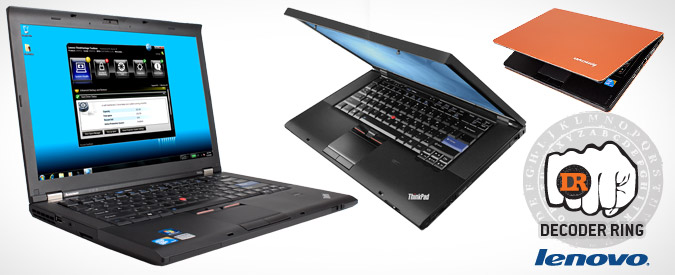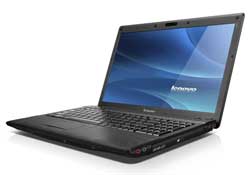Lenovo Laptop Decoder Ring: What the Model Numbers Mean
At first glance, Lenovo’s notebook model names can look like alphabet soup. Fortunately, you don’t need to stay up all night scratching your head and wondering how an IdeaPad Z530 differs from a ThinkPad L410. We’ve got a simple explanation of Lenovo’s model-naming scheme.
The most basic distinction in Lenovo’s naming structure is between its three main laptop lines: ThinkPad, IdeaPad, and “Essential” notebooks.
Lenovo ThinkPads
Lenovo’s ThinkPads are its world-famous business portables. Though the Edge series has a somewhat sleeker aesthetic, all ThinkPads share the same design heritage, complete with that iconic red TrackPoint in the middle of their keyboards.
Lenovo ThinkPads are divided into six series, each of which is designated either by a single letter or by the “Edge” series sub-brand.
The ThinkPad series are:
- X Series: The super-slim portable line includes the 11-inch ThinkPad X120e, the 12-inch ThinkPad X220 with its associated X220 convertible tablet, and the upcoming 13-inch ThinkPad X1.
- T Series: The popular thin-and-light ThinkPad series includes the 14-inch ThinkPad T410 and T420 and the 15-inch ThinkPad T510 and T520. Models ending ending in “s” (e.g., the T410s) are thinner and lighter than their counterparts.
- L Series: Mainstream, low-cost 14- and 15-inch notebooks with few special features.
- SL Series: Mainstream, low-cost notebooks such as the L Series, but targeted more at small businesses.
- W Series: Workstation-class performance in large 15- and 17-inch notebooks.
- Edge Series: Lenovo’s stylish ThinkPad line targeting small business users comes in 11- to 15-inch sizes. Edge series models beginning with “E” are new for 2011. Those ending in “s” have slimmer, more premium designs (e.g., ThinkPad Edge E220s).
Lenovo IdeaPads
Sign up to receive The Snapshot, a free special dispatch from Laptop Mag, in your inbox.
Lenovo targets IdeaPads toward mainstream consumers, though the IdeaPad V series is also marketed at small business users. IdeaPads don’t have the same overriding design ID as ThinkPads, and you won’t find a TrackPoint between their G and H keys, but they do have some truly unique designs.
Lenovo IdeaPads are divided into five series, each of which is designated by a single letter at the beginning of the model name:
- Y Series: This multimedia and gaming-oriented series comes in 14- and 15-inch designs, including the Y460 and the Y560. Models ending in “d” have 3D screens and those ending in “p” are optimized for best performance.
- U Series: With an emphasis on portability, the U Series includes 11-, 12-, 13-, and 14-inch models. The unique U1 Hybrid is an 11.6-inch notebook with a screen that detaches and becomes a tablet.
- V Series: With the tagline of “engineered for small business, designed for fun,” these notebooks blur the line between consumer and small business systems by providing security features such as fingerprint readers while sporting a very un-Thinkpad-like aesthetic. Available in 14- and 15-inch sizes.
- Z Series: Solid mainstream notebooks, IdeaPad Z Series systems come in 13-, 14-, and 15-inch sizes.
- S Series: Lenovo’s netbook line includes 10- and 12-inch variants. Also includes the S10 tablet.
Lenovo “Essential” Line
The “Essential” line could also be known as the line with no name, because the “essential” moniker is omitted from the model names of these budget-oriented systems.
Instead, these few-frills notebooks are named using series letters only. The two series letters are:
- G Series: Low-cost consumer notebooks in 14-, 15-, and 17-inch sizes.
- B Series: Budget business systems in 14- and 15-inch form factors.
General Tips:
- Screen Size: The first number in the model name represents the screen size (3 = 13-inch, 4 = 14-inch, etc.).
- Generation: The second number tells you the generation of notebook in this line, though Lenovo only began using its current naming system a few years ago. For example, the ThinkPad W520 is the third generation of W Series, following 2008’s W500 and 2010’s W510.



